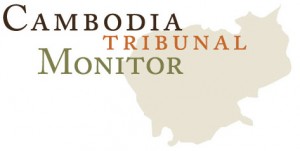Amb. Scheffer Speaks at Opening of US Holocaust Museum Exhibit on Khmer Rouge Atrocities
Address by Ambassador David Scheffer[1]
United Nations Secretary-General’s Special Expert on United Nations Assistance to the Khmer Rouge Trials
U.S. Holocaust Museum
Washington, D.C.
May 27, 2015
Four decades ago, as this country was fleeing Saigon, Pol Pot and the Khmer Rouge were launching their reign of atrocities on the Cambodian people. Some in this room, including Elizabeth Becker and Craig Etcheson, are experts of and written about that nearly four-year descent into hell, but it remained largely hidden from world view then and it has to this day. The least we can do is bring that episode of human evil into the shining light of public scrutiny. The U.S. Holocaust Museum has done precisely that with this exhibit. It is the story of a society in which everything made sense for Pol Pot’s cadre of delusional faithful and nothing made sense at all to millions of Cambodians. Atrocities were rationalized by their masterminds for the sole purpose of these individuals seizing power and holding onto it under the guise of an agrarian ideology. When victims—and there were an estimated 1.7 million who perished in Cambodia—are confronted with an ideology gone mad, they also endure the ultimate assault on their dignity and their lives. The rest of us, however, bear the responsibility to remember and to hold the perpetrators accountable under the rule of law. The same was and remains true of the Holocaust.
This exhibit demonstrates both remembrance and accountability; it will stir the millions who view it over the next two years—in this building and online—to realize how fragile human society can be when ruled by the determined architects of atrocity crimes. The Extraordinary Chambers in the Courts of Cambodia, a dominant feature of this exhibit, were established by treaty between Cambodia and the United Nations to bring to justice the surviving senior Khmer Rouge leaders and those most responsible for the atrocity crimes of the Pol Pot era. That is no easy task so many decades later; I should know in this, the 18th year since our initial efforts to create a tribunal and my fourth year as the Secretary-General’s Special Expert addressing issues that arise in the tribunal’s management and in its mandate of voluntary funding from governments. Americans in this audience should take pride in the fact that for several years the U.S. Government has been and remains the largest single donor, and in the beginning it was the engine behind the tribunal’s creation. Stephen Rapp, the U.S. Ambassador at Large for Global Criminal Justice, joins us today and we are thankful for all of his support over the years.
We are now in the second phase of the trial of two of Pol Pot’s top aides, Khieu Samphan and Nuon Chea, who were convicted by the Trial Chamber of other atrocity crimes during the first phase of their trial. Those convictions are now on appeal. The International Co-Investigating Judge is deeply immersed in the investigation and charging of additional suspects, a process that has the support of the United Nations and of the donor governments. In late March, Deputy Prime Minister Sok An and I issued a joint statement in Phnom Penh declaring “continuing full support for cooperation in implementation of all provisions of the ECCC Law and the UN/Cambodia Agreement in order to discharge the judicial mandate and procedures of the Extraordinary Chambers in the Courts of Cambodia.” I spend every day implementing and monitoring that statement.
We doubtless will see difficult times ahead, but at every juncture the United Nations and the Chambers’ donors have held firm in supporting the full mandate of the Extraordinary Chambers. We soldier on because it would be nothing less than shameful to abandon millions of victims who still deserve justice, however limited it might have to be given the passage of decades and limited resources.
This exhibit honors that endeavor, including the historic trials, the tireless advocacy of prosecutors, defense counsel, and civil party counsel, the investigations of mass crimes, the victims who testify and bear witness, and the growing body of jurisprudence informing both Cambodian and international criminal law.
Sadly, Syria, Iraq, North Korea, central Africa, the Ukraine—to name a few regions—are still generating atrocities that doubtless will require new exhibits of this character in the future. Nonetheless, we can hope that this Cambodian exhibit will be the last one for modern atrocity crimes of a magnitude second only to the Holocaust.
Let me close by acknowledging the leadership of Michael Abramowitz, the brilliant research of exhibit craftsman Greg Naranjo and his talented team, the ceaseless energy of Nadia, the museum donors (among whom I count myself a proud if modest member), and the overall support of the Holocaust Museum for making all of this possible. I would be remiss if I did not also thank the JB and MK Pritzker Family Foundation for its early support of my own efforts with establishing and managing the Cambodia Tribunal Monitor and the vision we had, and Michael Abramowitz amplified, for a museum exhibit about the Cambodian atrocities.
And thanks to all of you for attending the opening of this stellar exhibition.
[1] Ambassador Scheffer spoke in his personal capacity at this event and his views do not necessarily reflect those of the U.N. Secretary-General or of the United Nations.
